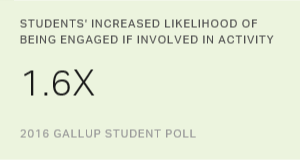
Why Schools Should Inspire Students to Do What They Do Best

Many talented teachers and coaches have a knack for spotting and fostering innate talent in others. They are driven to maximize the potential of every student and athlete who they serve.
My daughter Miriam graduated from high school this year, and she was blessed to have such a coach.
Four years ago, Miriam was a gymnast who competed successfully at her first regional gymnastics meet. A few weeks later, she suffered a career-ending injury while practicing a new skill. Like many athletes who have their careers unexpectedly cut short, she was afraid of what her new life outside of the gym would look like.
Coach Suing, a high school teacher and pole vault coach, came to the rescue. She recruited Miriam, knowing that former gymnasts sometimes make strong pole vaulters. (Candidly, I would have preferred that she try an activity that kept both feet firmly planted on the ground!) Miriam improved over time and became a capable "high flyer," setting a school record along the way.
Coach Suing helped Miriam to manage her injury and reinvent her athletic career. And more importantly, she helped her to regain confidence in her abilities and pushed her to find new ways to use her skills and talent. At a time when Miriam was experiencing sadness and self-doubt, Coach Suing stepped in and steered her to become more involved and engaged with school and hopeful for the future.
Involvement in activities and getting to do what they do best every day at school is linked to positive outcomes for students. Findings from the 2016 Gallup Student Poll -- a survey of students in grades five through 12 -- show that students who strongly agree they are involved in at least one activity, such as a club, music, sports or volunteering, are 1.6 times more likely to be engaged at school than students who do not strongly agree. This same group who strongly agree they are involved in an activity are also:
- 1.7x more likely to be hopeful for the future
- 2.1x more likely to say they get excellent grades
- 2.1x more likely to say they do well at school
Additional analysis of Gallup Student Poll data shows that getting to do what they do best every day at school is a top driver of self-reported excellent grades for high school students.
These findings are from the 2016 Gallup Student Poll Snapshot Report and reflect results from the eighth annual Gallup Student Poll, which provides insights into how students experience their lives in and out of school.
Gallup conducted the survey via web Sept. 26-Oct. 28, 2016, and included more than 3,000 public and private schools in the U.S. and Canada that opted to participate in the survey in 2016. Nearly 5 million surveys have been completed by students from thousands of schools that opted to participate in the survey since the pilot was launched in spring 2009. The Gallup Student Poll includes four elements: engagement with school, hope for the future, entrepreneurial aspiration, and career and financial literacy.
Extracurricular and co-curricular activities afford important opportunities for students to figure out what they do best, identify and develop their strengths, and learn to appreciate the strengths and contributions of others.
Talented teachers and coaches know this and support students in their journey to discover what they do best and develop and apply their strengths every day. Using the lens of "strengths" to inform personal growth and development has positive outcomes for people and organizations. Gallup research shows that strengths-based organizations are not only more engaged with their work, but they are more productive and successful.
The sooner students begin to learn more about themselves and what they do best, the more prepared they will be to use their strengths to benefit their future workplaces and communities. Coaches and teachers, like Coach Suing, who intentionally spot and develop talent in their students and athletes, are helping to engage students with school today and prepare them to live their best lives in the future. And parents, like me, are very grateful.
Learn more about improving student engagement in the 2016 Gallup Student Poll Snapshot Report.
Does your school know the best ways to help students, staff and parents identify and develop their strengths? Gallup can help.
Daniela Yu, Senior Researcher, Predictive Analytics, provided analytics for this article.
Survey Methods
Gallup Student Poll results and findings are based on surveys collected from 918,828 students in grades five through 12, representing more than 3,000 schools from more than 540 school districts across 49 states, Washington, D.C., and Canada. The online poll was completed by a convenience sample of schools and districts from Sept. 26-Oct. 28, 2016. Gallup does not randomly select schools participating in the Gallup Student Poll nor does Gallup charge or provide any incentives for participation beyond school-specific data. Participation rates vary by school. The survey is anonymous and only group data are reported.
The annual Gallup Student Poll is offered at no cost for U.S. schools and districts. Gallup Student Poll data are not statistically weighted to account for non-response bias; therefore the overall data from the annual administration of the Gallup Student Poll may not be generalizable to the U.S. student population of fifth- through 12th-grade students.
This fall, the Gallup Student Poll will be available at no cost to schools in the U.S. and Canada from Sept. 25-Oct. 27, 2017.
